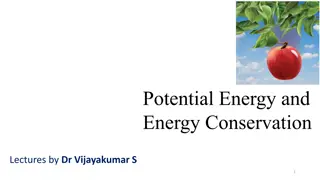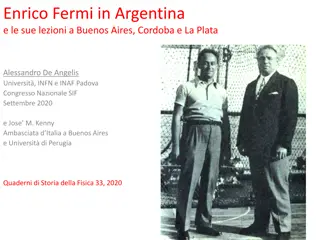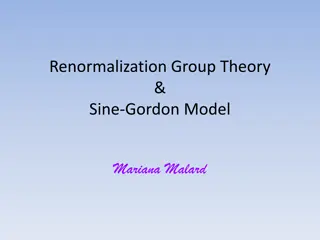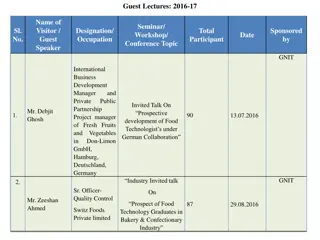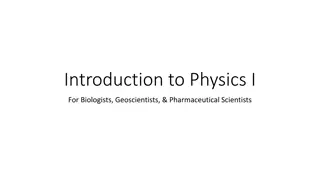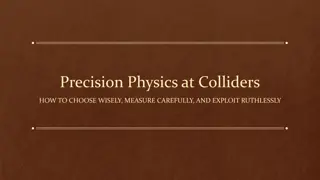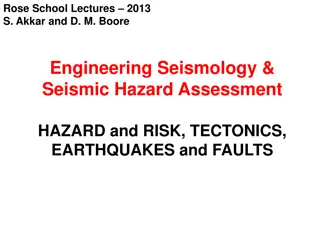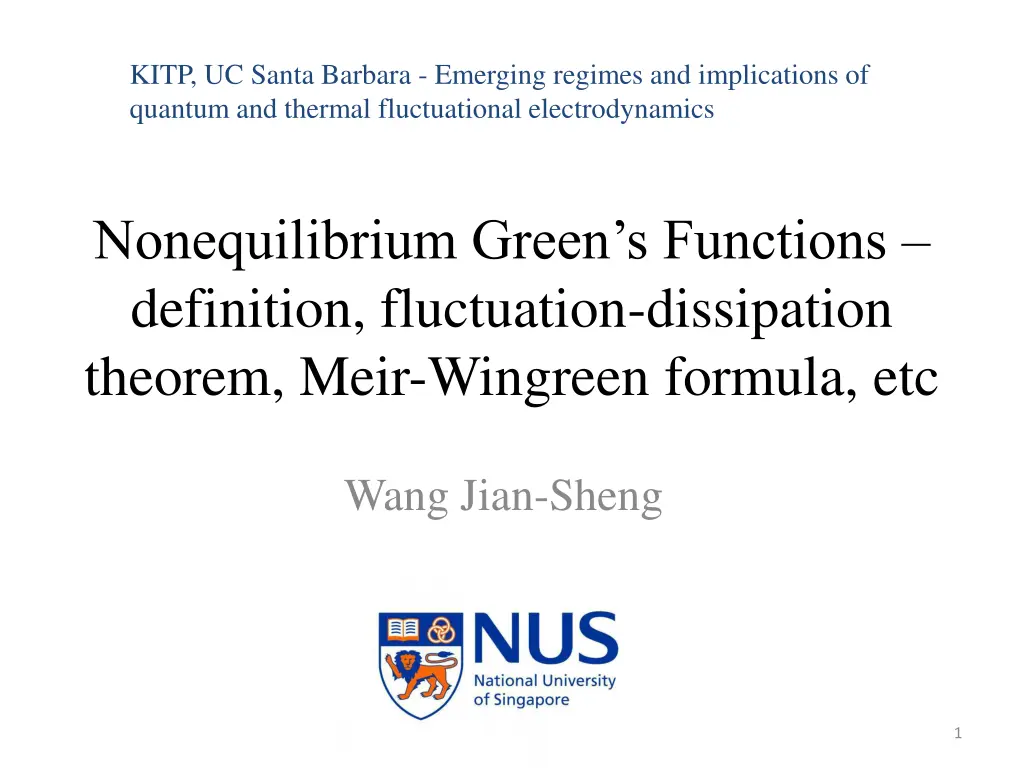
Emerging Regimes in Quantum and Thermal Fluctuational Electrodynamics
Explore the concepts of nonequilibrium Green's functions, fluctuation-dissipation theorem, and Meir-Wingreen formula in quantum and thermal fluctuational electrodynamics. Topics include NEGF technologies, perturbation theory, and single electron quantum mechanics.
Download Presentation

Please find below an Image/Link to download the presentation.
The content on the website is provided AS IS for your information and personal use only. It may not be sold, licensed, or shared on other websites without obtaining consent from the author. If you encounter any issues during the download, it is possible that the publisher has removed the file from their server.
You are allowed to download the files provided on this website for personal or commercial use, subject to the condition that they are used lawfully. All files are the property of their respective owners.
The content on the website is provided AS IS for your information and personal use only. It may not be sold, licensed, or shared on other websites without obtaining consent from the author.
E N D
Presentation Transcript
KITP, UC Santa Barbara - Emerging regimes and implications of quantum and thermal fluctuational electrodynamics Nonequilibrium Green s Functions definition, fluctuation-dissipation theorem, Meir-Wingreen formula, etc Wang Jian-Sheng 1
Outline Lecture 0: Electron Green s functions Lecture 1: NEGF brief history, phonons/harmonic oscillator example Lecture 2: NEGF technologies equation of motion method, Langreth rules, heat current formula (Meir-Wingreen, Landauer). 2
References J.-S. Wang, J. Wang, and J. T. L , Quantum thermal transport in nanostructures, Eur. Phys. J. B 62, 381 (2008). J.-S. Wang, B. K. Agarwalla, H. Li, and J. Thingna, Nonequilibrium Green s function method for quantum thermal transport, Front. Phys. 9, 673 (2014). J.-S. Wang, J. Peng, Z.-Q. Zhang, Y.-M. Zhang, and T. Zhu, Transport in electron-photon systems , manuscript in preparation. 3
Lecture Zero Green s function for free electrons 4
Single electron quantum mechanics Ht = d i = , ( ) t (0) i H e dt We define the (retarded) Green's function by 1, 0, 0 0 t t i = ( ) t e = / r iHt ( ) , ( ) t G t then = ( ) (0), r ( ) t 0 i G t t 5
Greens function in energy space Fourier transform to space E + + E i + H i i = = / / iEt t ( ) ( ) G E G t e dt e dt 0 ( ) 1 + = + i , 0 E H ? ? 1 is called resolvent of the operator ?. 6
Perturbation theory, single electron = h V + H = + 1 1 1 1 use ( ) A B B B A A ( ) ( ) 1 1 = = = = = + i r r Let , , G A z H g B z h z E = + r r r r then G g g VG The last equation is known as the Dyson equation, equivalent to the Lippmann-Schwinger equation 7
Annihilation/creation operators ( ) c ( ) c 2 2 = = j 0, 0, Pauli exclusion principle j + = k c c c c defining property of fermion j k j jk + = 0 c c c c j k k j + = j c c k c c 0 k j = j |0 |1 c j 8
Many-electron Hamiltonian and Green s functions c c H c Hc c = = 1 Annihilation operator c is a column vector, H is N by N matrix. {A, B} =AB+BA 2 , ... c N i = r jk k ( , ') t t ( ') { ( ), c t c t ( ')} G t t j i = k ( , ') t t ( ) ( ') c t c t G jk j 9
Why Greens functions? Solutions to differential equations Retarded Green s function is related to the linear response theory Im ??gives electron density of states Related to (non-equilibrium) physical observables such as the electron or energy current 10
Lecture Two History, definitions, properties of NEGF 12
A Brief History of NEGF Schwinger 1961 Kadanoff and Baym 1962 Keldysh 1965 Caroli, Combescot, Nozieres, and Saint-James 1971 Meir and Wingreen 1992 13
Equilibrium Greens functions using a harmonic oscillator as an example Single mode harmonic oscillator is a very important example to illustrate the concept of Green s functions as any phononic system (vibrational degrees of freedom in a collection of atoms) and photonic system at ballistic (linear) level can be thought of as a collection of independent oscillators in eigenmodes. Equilibrium means that system is distributed according to the Gibbs canonical distribution. 14
Harmonic Oscillator m 2 k 1 2 p = + = 2 , H kx u x m 2 m 1 2 1 2 1, 2 k m = + = + = 2 2 2 H u u a a ( ) = + = ] 1 = , [ , ] x p , [ , u a a i a a 2 15
Eigenstates, Quantum Mech/Stat Mech 1 2 = = + = , , 0,1,2, H n E n E n n n n = = + + 1 , 1 1 a n n n a n n n H 1 e = = , ( ) H k T Tr e B = = = = 0, 1 aa a a a a aa N 1 ( ) = = Tr , N 1 e 16
Heisenberg Operator/Equation Ht Ht i i O: Schr dinger operator O(t): Heisenberg operator = ( ) O t dO t dt e Oe ( ) 1[ ( ), O t H i = ] ( ) dt 1 i 1 i 1 2 da t ( ) = = + [ ] [ ( ), a t H ] ( ), a t ( ) ( ) a t a t = = ( ) i a t i t i t + = ( ) , ( ) a t ae a t a e 17
Defining >, <, t, Greens Functions t i = = ( , ') ( ) ( ') , u t u t 1 g t t i ( ) i t = + = ( ) ( ) ( ) , ( ) u t a t a t a t ae 2 i = + + ( ') ( ') i t t i t t ( , ') (1 ) g t t Ne N e 2 18
i = = ( , ') ( ') ( ) u t u t ( ', ) g t t g t t i = = + t ( , ') g t t ( ) ( ') Tu t u t ( ') ( , ') ( ' t ) ( , ') t t g t t t g t t i = = + t ( , ') ( ) ( ') Tu t u t ( ' t ) ( , ') ( ') ( , ') g t t t g t t t t g t t : time order : anti-time order T T 1, 1 2 0, if 0 t = = ( ) t , if 0 t if 0 t 19
Retarded and Advanced Greens functions i = r ( , ') ( ') [ ( ), ( ')] u t u t g t t t t sin ( ') t t = ( ') , t t i = = a r ( , ') ( ' t ) [ ( ), ( ')] u t u t ( ', ) g t t t g t t + = = 2 r r r ( ) ( ) ( ), t with ( ) 0 for 0 g t g t g t t 20
Fourier Transform + + d i t i t [ ] = = [ ] r r r r ( ) , ( ) g g t e dt g t g e 2 + sin( ) t i t [ ] = r t ( ) t g e dt 1 + = , 0 ( ) 2 + i 2 1 [ ] = [ ] , = * a r g g N 1 e i [ ] = + + ) ( + ( ) (1 ) g N N 21
Plemelj formula, fluctuation- dissipation, Kubo-Martin-Schwinger condition P for Cauchy principle value 1 + 1 x = ( ) x P i x i ( ) [ ] = [ ] [ ] ( ) r a g g g N Valid only in thermal equilibrium = [ ], [ ] ( ) g e g = + ( ) g t g t i 22
Matsubara Greens Function 1 ( , ') ( ) ( ') T u u = M g 1 = + + ( ') ( ') (1 ) Ne N e 2 H H + = i = where 0 ( ) g , ' ( , ( ) ) ( ) u u e ue = M M g 2 n = ( ) = = , 1,0,1,2, i M M [ ] , , g i g e d n n n n 0 [ [ ] = + i r M ] g g i n 23
Nonequilibrium Greens Functions By nonequilibrium , we mean, either the Hamiltonian is explicitly time-dependent after t0, or the initial density matrix is not a canonical distribution. We ll show how to build nonequilibrium Green s function from the equilibrium ones through product initial state or through the Dyson equation. 24
Definitions of General Greens functions (phonon/displacement) i i = = ( , ') t t ( ) ( ') , ( , ') t t ( ') ( ) G u t u t G u t u t jk j k jk k j = = + + t ( , ') ( , ') ( ( ' t ') ) t G t t ( , ') ( , ') ( ' ( t ) ') ( , '), ( , ') G t t t t G t t t t G t t t G t t t G t t ( ) ) = r ( , ') ( ') , G t t t t G G ( ) = a ( , ') ( ' t G t t t G G 25
Relations among Greens functions + = = = + + = = r a G G G G iA = = t t K r t , G G G G G G G G t t r a a t , G G G G G G G = ( , ') t t ( ', ) G G t t jk kj = r jk a kj ( , ') t t ( ', ) G G t t 26
Steady state, Fourier transform = ( , ') G t t ( '), G t t + i t [ ] = ( ) , G G t e dt [ ] = [ ] r a G G 27
Equilibrium Greens Function, Lehmann Representation H e = = = E | | , , H n E n Z e n n Z n Ht Ht i i = | 1 = ( ) , | u t e u e m m j j m i = u t u ( ) t Tr ( ) (0) G jk j k 1 Z i = E | ( ) (0)| e n u t u n n j k n ( ) E E t 1 Z i n m + E i = n | | | | e n u m m u n j k , n m 28
Fluctuation-Dissipation Theorem (Callen-Welton 1951) ?<? = ? ? ??? ??? ?>? = (1 + ? ? ) ??? ??? Fluctuations: < ?? > Linear response: ? = ???, Dissipation: ? Im ?? ?2 ? is force 29
Pictures in Quantum Mechanics Schr dinger picture: O, (t) =U(t,t0) (t0) Heisenberg picture: O(t) = U(t0,t)OU(t,t0) , 0, where the evolution operator U satisfies ( , ') ( , '), t i H U t t t = U t t = See, e.g., Fetter & Walecka, Quantum Theory of Many- Particle Systems. i t '' H dt '' t ( , ') U t t , ' Te t t ' t 30
Calculating correlation 0 0 Tr ( ) ( , ) t U t t AU t t BU t t = = = = ( ) ( ') A t B t ( ) ( ') A t B t Tr ' t t Tr ( ) ( , ) t U t t AU t t U t t BU t t ( , ) ( , ') ( ', ) 0 0 0 0 ( ', ) 0 ( , ') 0 i H d ( ) t T e Tr , AB C 0 ' C t t B A i t '' H dt = '' t ( , ') ( , ') ( ', '') U t t U t t , ( , '') U t t U t t Te ' t = t t t0 31
Evolution Operator on Contour i 2 ( , ) = exp , U T H d 2 1 2 1 c 1 ( , ) ( , ) U = = ( , ), U U 3 2 2 ( , ) , 1 3 1 3 2 1 1 ( , ) U U 1 2 2 1 1 2 + + ( ) = ( , ) ( , ) U t O OU t 0 0 Keldysh contour 32
Contour-ordered Greens function i ( , ') = ( ) ( ') u T G T u C i H d = ( ) t T u u T Tr e C 0 ' C Contour order: the operators earlier on the contour are to the right. See, e.g., H. Haug & A.- P. Jauho. t0 33
Relation to real-time Greens functions ( , ), t = = or , t t G G G G ( , ') = ' ( , ') t t or G G G t ++ + = = = = t , G G G G + t , G G G G = r t G G G t0 34
Lecture three Calculus on contour, equation of motion method, current, etc 36
Equation of Motion Method The advantage of equation of motion method is that we don t need to know or pay attention to the distribution (density operator) . The equations can be derived quickly. The disadvantage is that we have a hard time justified the initial/boundary condition in solving the equations. Diagrammatic expansion (initial product states satisfy Wick s theorem) 37
Heisenberg Equation on Contour i 2 ( , ) = exp , U T H d 2 1 2 1 c 1 + + ( ) = ( , ) ( , ) U t O OU t 0 0 ( ) dO = [ ( ), O ] i H d 38
Express contour order using theta function i ( , ') = ( ) ( ') u T G T u C i i T = ( ) ( ') u ( , ') + ( ') ( ) u ( ', ) T T u u Operator A( ) is the same as A(t) as far as commutation relation or effect on wavefunction is concerned [ ( ), ( ) ] u u = T i I 39
Equation of motion for contour ordered Green s function i i T ( , ') = ( ) ( ') u ( , ') + ( ') ( ) u ( ', ) T T G u u i i T ( ) + ( ) ( ') u ( , ') + ( ') ( ) u ( ', ) T T u u i = ( ) ( ') u T T u C 2 i ( , ') = ( ) ( ') u ( , ') T G u 2 i i i T ( ) + ) ( ') u ( , ') + ( ') ( ) u ( ', ) T T ( u u i = ( ) ( ') u + [ ( ), ( ') ] u u ( , ') T T T u C i = ( ) ( ') ) u ( , ') T ( T Ku I C = ( , ') ( , ') KG I 40
Equations for Greens functions 2 ( , ') + ( , ') ( , ') = G KG I 2 2 + = ' = ' ' ( , ') t t ( , ') t t ( ') , t I , ' G KG t 2 t 2 + = , , r a t , , r a t ( , ') t t ( , ') t t ( ') G KG t t I 2 t 2 + = t t ( , ') ( , ') ( ') G t t KG t t t t I 2 t 2 + = , , ( , ') t t ( , ') t t 0 G KG 2 t 41
Solution for Greens functions 2 + = , , r a t , , r a t ( , ') t t ( , ') t t ( ') G KG t t I 2 t using Fourier transform: [ ] G + [ ] = 2 , , r a t , , r a t KG I ( ) 1 [ ] = + + + , , r a t 2 ( ) ( ) G I K c K d K ( ) 1 + + [ ] = [ ] = + i 2 r a ( ) , 0 G G I K = = = r a ( ), G N G G G e G c and d can be fixed by initial/boundary condition. + t r G G G 42
Junction system ? Cool bath System Hot Bath Key point: reducing from an infinite size problem to finite degrees of the center through self-energy. 43
Junction system, adiabatic switch-on g for isolated systems where leads and centre are decoupled G for coupled ballistic nonequilibrium system HL+HC+HR +V G HL+HC+HR g t= Equilibrium at T t = 0 Nonequilibrium steady state established 44
Sudden Switch-on HL+HC+HR +V Green s function G HL+HC+HR g t= Equilibrium at T t= t =t0 Nonequilibrium steady state established 45
Three regions 1 L u u u u u L = = = 2 L , , u u u C L C R i ( , ') = ( ) ( ') = T , , , , L C R G T u u C 46
Heisenberg equations of motion in three regions = + + + + + T L LC T R RC , H H H H u V u u V u H L C R C C n 1 2 1 2 = + T T , H u u u K u 1 i 1 i 1 i = = + C CL CR [ , ], [ , ], u u H H K u V u V u u H C C C L R C n = = C , , u K u V u L R C 47
Force Constant Matrix L LC 0 K V V K V = CL C CR , K V K RC R 0 u L 1 2 1 2 ( ) = + T T L T C T R H p p u u u K u C u R u u u L = = p u C R 48
Relation between g and G Equation of motion for GLC i ( , ') = ( ) ( ') T , G T u u LC C L C 2 i ( , ') = ( ) ( ') T G T u u LC C L C 2 = ( , ') ( , '), L LC K G V G LC CC ( , ') = ( , '') ( '', ') LC '', G g V G d LC L CC 2 ( , ') + ( , ') ( , ') = L g K g I L L 2 49
Dyson equation for GCC i T u u = ( , ') T ( ) ( ') , G CC C C C 2 i ( , ') = ( ) ( ') ( , ') T G T u u I CC C C C = 2 ( , ') ( , ') ( , ') ( , ') C CL CR K G V G V G I CC LC RC = ( , ') ( , '') ( '', ') C CL LC '' K G V g V G d CC L CC ( , '') ( '', ') , '), CR RC '' ( V g V G d I R CC ( , ') = ( , ') + ( , ) ( , ( , ') d d ) , G g g G 1 1 2 2 1 2 CC C C CC ( , ') = ( , ') + ( , ') CL LC CR RC V g V V g V L R 50





